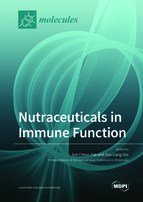Nutraceuticals in Immune Function
A special issue of Molecules (ISSN 1420-3049). This special issue belongs to the section "Natural Products Chemistry".
Deadline for manuscript submissions: closed (15 April 2021) | Viewed by 134605
Special Issue Editors
Interests: evidence-based practice; bee venom; nutrition; reproduction; cancer; natural medicine
Special Issues, Collections and Topics in MDPI journals
Interests: evidence-based complementary medicine; nutrition; naturopathy; phytotherapy; natural medicine
Special Issues, Collections and Topics in MDPI journals
Special Issue Information
Dear Colleagues,
Most diseases are preventable, and they are related to what we eat. Moreover, most doctor visits are for lifestyle-based diseases, which means they can be prevented by adopting a healthy lifestyle. Treating the causes of illness rather than symptoms of the disease is not only safer and cheaper, but it can work better. Primordial prevention is a good example because it encompasses not just preventing chronic disease but preventing its related risk factors. In this context, claims abound for the competitive merits of nutraceuticals for preventing and treating many chronic diseases by targeting the underlying cause of illness and enhancing the immune system.
Nutraceutical, a term derived from ‘nutrition’ and ‘pharmaceutical’, refers to any product isolated from herbs, nutrients, specific diets, processed foods, and beverages that are used not only for nutritional but also for medicinal purposes. Many nutraceuticals possess therapeutic properties which can affect the immune system. For example, nutraceuticals derived from a variety of mushrooms are known to modify cytokine production in different cancer models; fermented rice bran products can modulate the natural killer cell function to improve immunosurveillance. Similarly, a variety of flavonoids from plants are now being investigated not only for their antioxidant effects but also their anti-inflammatory properties.
This Special Issue provides an open forum for researchers to share their research findings in this growing field of interest. We welcome contributions in the forms of both original research and review articles that assess the impact of nutraceuticals on the immune function.
Dr. Sokcheon Pak
Mr. Soo Liang Ooi
Guest Editors
Manuscript Submission Information
Manuscripts should be submitted online at www.mdpi.com by registering and logging in to this website. Once you are registered, click here to go to the submission form. Manuscripts can be submitted until the deadline. All submissions that pass pre-check are peer-reviewed. Accepted papers will be published continuously in the journal (as soon as accepted) and will be listed together on the special issue website. Research articles, review articles as well as short communications are invited. For planned papers, a title and short abstract (about 100 words) can be sent to the Editorial Office for announcement on this website.
Submitted manuscripts should not have been published previously, nor be under consideration for publication elsewhere (except conference proceedings papers). All manuscripts are thoroughly refereed through a single-blind peer-review process. A guide for authors and other relevant information for submission of manuscripts is available on the Instructions for Authors page. Molecules is an international peer-reviewed open access semimonthly journal published by MDPI.
Please visit the Instructions for Authors page before submitting a manuscript. The Article Processing Charge (APC) for publication in this open access journal is 2700 CHF (Swiss Francs). Submitted papers should be well formatted and use good English. Authors may use MDPI's English editing service prior to publication or during author revisions.
Keywords
- Nutraceutical
- Immune system
- Herbs
- Food supplement
- Nutrition








